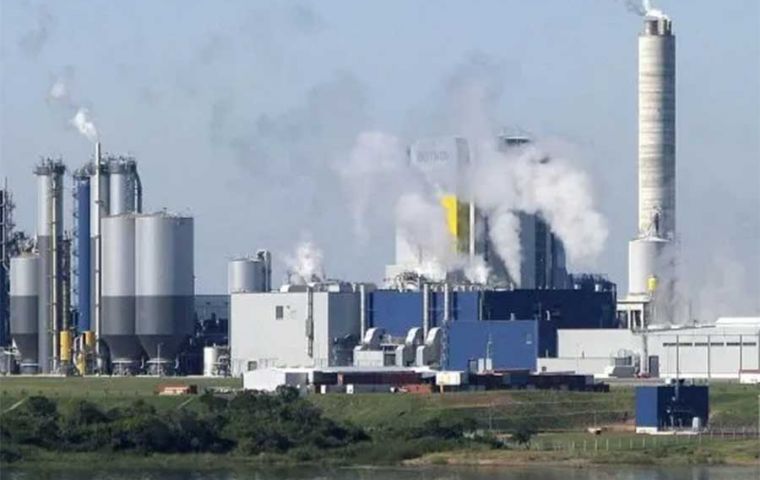MercoPress. South Atlantic News Agency
Steady increase of eucalyptus pulp prices boosted by Chinese demand; jumps of US$ 50 and US$ 80 per ton
 Uruguay's UPM pulp mill along a shared river with Argentina
Uruguay's UPM pulp mill along a shared river with Argentina Good news for Mercosur pulp industry. After monthly price increases for eucalyptus pulp since June, China has surprised producers and analysts by showing stronger than expected demand for the fiber.
According to the Pulp and Paper Products Council (PPPC), in the first eight months of the year, shipments to the world’s second-largest economy increased by nearly 22% —42.4% in August— fueling successive rounds of successful adjustments, which are also reflected in the European and U.S. markets, where demand remains weak.
Suzano, the world’s largest market pulp producer, announced in mid October new increases for eucalyptus fiber for November in all regions. This will be the sixth month of increases in China and the third month in Europe and North America. The increases range from US$50 to US$80 per ton and indicate that the October round has also been fully implemented in all markets.
According industry analysts the new increase is supported by declining inventories at ports in various countries, the heated demand for pulp and paper, and the spread between hardwood pulp and softwood pulp above historical levels.
“China is carrying the team on its back, more than compensating for the declines in Europe and the United States,” said Daniel Sasson, an analyst at Itaú BBA, referring to the latest PPPC data. While shipments in China rose 21.7% to 12.94 million tons for the year, Europe and North America saw declines of 18.5% and 8.9% to 7.28 million and 4.77 million tons, respectively.
In Asia, demand for pulp and paper is strong, resulting in a double-digit increase in production compared to the same period last year. Higher paper exports and a resumption of consumption after the pandemic explain this behavior.
This time the increase will be US$ 50 in China, bringing the total announced since the end of May to US$ 160 per ton. Considering that the net price of hardwood pulp (BHKP), as measured by the Fastmarkets PIX index, was around US$ 578 per ton last week, the value of the raw material would reach US$ 630 per ton in November.
The intensity of the correction came as a surprise, said Mr. Sasson. The expectation was for announcements of US$ 20 a tonne for November and then December. “This US$ 50 all at once, in November, shows that, in the company’s perception, the market is tighter in the short term than we imagined.”
A general movement to rebuild inventories of the raw material and the success of Chinese paper companies in applying adjustments, with a recovery in margins, explain the recent stronger demand, said the analyst.
In a report last week, Bank of America (BofA) raised its hardwood pulp price expectation for the year to US$ 603 per ton from US$ 588 per ton. “Despite the likely increase in pulp supply, we see little chance of price pressure as current levels are very close to supporting production costs,” wrote analysts led by Caio Ribeiro.
Mr. Sasson of Itaú BBA said there is room for much of the new adjustment, especially in China, and the trend is for this movement to be accompanied by Europe and North America, so that the price difference between the regions doesn’t become so pronounced. However, in 2024, with the additional capacity from Arauco’s Mapa project and UPM’s new mill at full capacity, and the start-up of Suzano’s Cerrado project, the trend is for more pressure on prices.
In Europe, Suzano said the November adjustment will be US$ 80 per ton, bringing the list price to US$ 980 per ton. Similarly, in North America, the increase is US$ 80, bringing the reference price to US$ 1,170 per ton.
According to Suzano, there has been a resumption of orders from European paper mills, indicating the end of destocking in the paper chain. In addition, unexpected mill stoppages, particularly at high-cost producers, have affected the supply of hardwood and softwood pulp, with a price differential that encourages a shift to the former.




Top Comments
Disclaimer & comment rulesCommenting for this story is now closed.
If you have a Facebook account, become a fan and comment on our Facebook Page!